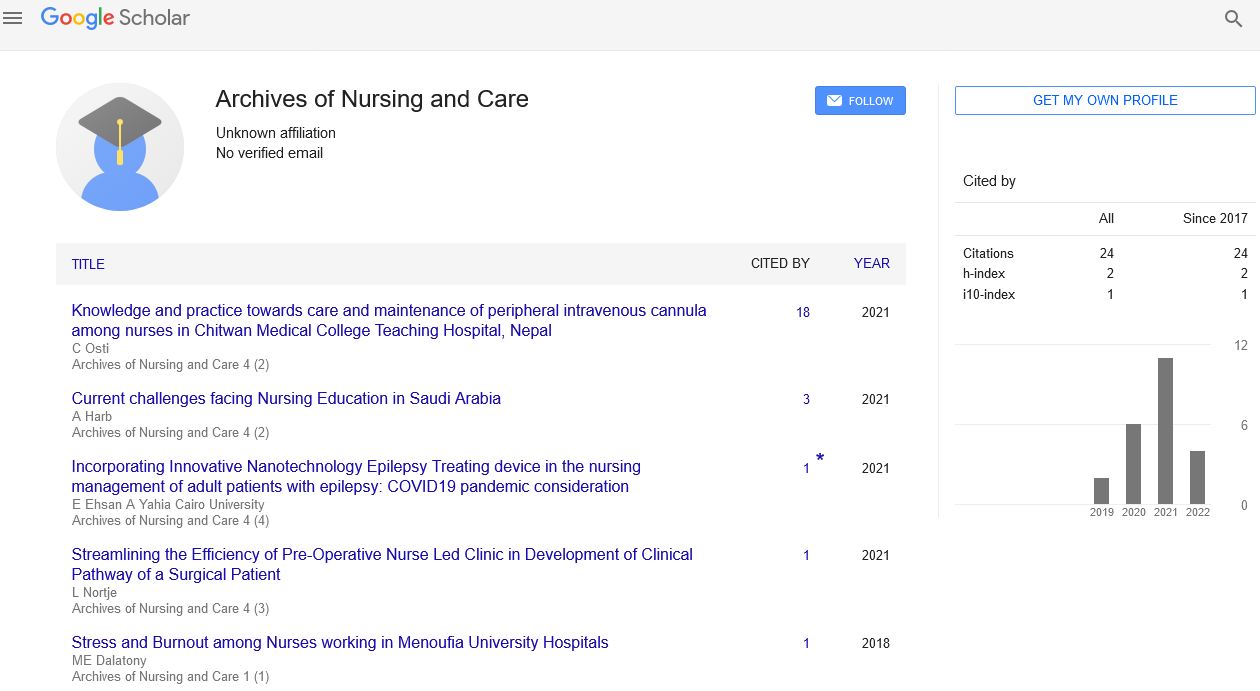Mini Review - Archives of Nursing and Care (2023) Volume 6, Issue 2
Obstetric Nursing with prenatal care
Wilson Christopher*
Saint Anselm College Department of Nursing, United States
Saint Anselm College Department of Nursing, United States
E-mail: christopherwilson@rediff.com
Received: 03-Apr-2023, Manuscript No. OANC-23-89183; Editor assigned: 05-Apr-2023, PreQC No. OANC-23- 89183 (PQ); Reviewed: 19-Apr-2023, QC No. OANC-23-89183; Revised: 24-Apr-2023, Manuscript No. OANC-23- 89183 (R); Published: 28-Apr-2023; DOI: 10.37532/oanc.2023.6(2).016- 018
Abstract
Obstetrical nurses assist with prenatal care, prenatal testing, care for patients dealing with pregnancy difficulties, care during labour and delivery, and postpartum care. Obstetricians, midwives, and nurse practitioners frequently collaborate with obstetrical nurses.
Introduction
A nursing speciality known as perinatal nursing or obstetrical nursing, deals with patients who are trying to conceive, are pregnant, or have just given birth. Obstetrical nurses assist with prenatal care, prenatal testing, care for patients dealing with pregnancy difficulties, care during labour and delivery, and postpartum care. Obstetricians, midwives, and nurse practitioners frequently collaborate with obstetrical nurses. Additionally, they oversee surgical technologists and patient care technicians [1].
Postoperative care, stress test analyses, cardiac and vascular monitoring, and health evaluations are all tasks carried out by obstetrical nurses on a surgical unit. Specialized abilities including computerised foetal monitoring, non-stress diagnostics, neonatal resuscitation, and medicine delivery by continuous intravenous drip are necessary for obstetrical nurses.
Because they frequently care for multiple patients at once, obstetrical nurses are also required to be meticulous and organised. Since nurses spend most of their workdays standing up, it is crucial that they have the mental and physical fortitude to do jobs with skill. Because they will have to deal with emergency and grief, nurses need to have strong emotional stability. Finally, they must be able to think critically because the patient's condition might change suddenly and they must be prepared to act swiftly and accurately [2].
A nursing speciality known as perinatal nursing or obstetrical nursing, deals with patients who are trying to get pregnant, are already pregnant, or have already given birth. Obstetrical nurses assist with prenatal care, prenatal testing, care for patients dealing with pregnancy difficulties, care during labour and delivery, and postpartum care. Obstetricians, midwives, and nurse practitioners frequently collaborate with obstetrical nurses. Additionally, they oversee surgical technologists and patient care technicians. Also prevalent in hospital maternity wards and birthing facilities are obstetric nurses [3].
With the goal of enhancing the lives of women and children by providing the best nursing education to professionals towards enhancing the health of women and children in an ever-changing healthcare environment, the Department of Obstetrics and Gynecological Nursing proposes an equivalent combination of education and experience. It provides the comprehensive knowledge required for the contemporary care of women's health together with current, therapeutically pertinent material [4].
In accordance with the curriculum set forth by West Bengal University of Health Sciences and the Indian Nursing Council, the department offers courses in obstetrics and gynaecological nursing for GNM and B.Sc students in order to prepare them as highly qualified and skilled carers for the general safety and wellbeing of women from the time of menarche until menopause as well as newborns. The department takes great delight in praising students' accomplishments in clinical practise and community services and in preparing them to carry out their duties as registered nurses, specialists, educators, and administrators in a range of Obstetric and Gynecological care settings [5].
The Department vowed to promote students' professional and personal growth in a welcoming, respectful, and adaptable environment. Students have the chance to study and hone the skills required for midwifery practise in the clinical laboratories. Students learn a variety of clinical skills necessary for safe practise under supervision throughout their time in the clinical skill laboratories [6].
Discussion
Obstetric Nursing in Labor and Delivery Care Best Practices
To assess the association of Obstetric Nursing in the best delivery and birth care practises in maternity hospitals. 666 women were chosen for delivery in a cross-sectional research. Professional parturition obstetric practises were divided into three categories: those that are obviously beneficial and should be promoted, those that are obviously detrimental or ineffectual and should be stopped, and those that are incorrectly utilised during parturition. In hospitals where obstetric nursing was employed, clearly beneficial practises were applied in higher proportions, whereas plainly detrimental and unsuitable procedures were applied in lower proportions, both with statistical difference. When compared to those that do not, facilities with obstetric nursing embrace better delivery and birth care methods that are based on scientific evidence [7].
Best practises for labour and delivery care according to obstetric nursing
Many women's lives revolve around giving birth, which has traditionally been a private event shared only with other women, their family members, and midwives. These provided delivery care based on the common knowledge and experience created within their communities and were thought to be trustworthy individuals for the expectant women or to have acknowledged experience in the community [8].
The care given to women during childbirth has been significantly influenced by biological research as a result of historical changes in the ways of life brought about by science that have helped to cement attitudes that favour powerful technology, economic gain, and these changes. The popular care given to women was replaced with a technocratic care model based on the body's conception as a machine for women as an object and of delivery as a risky event. The technocratic paradigm
The technocratic paradigm suggested institutionalising childbirth and delivery in hospitals, combining a number of standardised obstetric procedures, and giving technology priority over interpersonal relationships. When carried out without scientific justification or guidelines, such interventionist methods have turned the obstetric context into a frequent scene of violence and may raise the likelihood of problems following delivery. All of these factors combined to create the phenomenon known as the "Perinatal Paradox," which refers to the persistence of high rates of maternal and perinatal illness and mortality as a result of subpar medical care and the usage of antiquated and iatrogenic procedures [9].
Maternal death rates are rising as a result of the alarmingly high number of caesareans, particularly those carried out without a medical reason. Even though caesareans are voluntary, evidence suggests that they are also linked to greater rates of postdelivery antibiotic use and a rise in preterm babies. Furthermore, high caesarean section rates result in enormous additional costs for already overburdened and frequently vulnerable health systems.
Why abuse patients by nurses? Observations from the obstetric services
The study of nurse-patient relationships has received very little empirical attention, particularly in developing nations as opposed to industrialised ones. Although "caring" is frequently emphasised in nursing discourse, nursing practise is frequently quite different and may be more strongly characterised by physical abuse and patient humiliation. This study presents and discusses the research's findings on health seeking behaviours in one area of the South African maternity services in order to answer the question: Why do nurses abuse patients? The qualitative study was based on 103 minimally organised in-depth individual interviews with patients and service employees as well as four group discussions. Many of the patients complained of verbal and physical abuse, as well as clinical neglect, from the nursing staff, who were sometimes reactive and other times ritualistic. Analysis of the data revealed a complex interplay of concerns including organisational issues, professional insecurities, a perceived need to assert "control" over the environment and sanctioning the use of coercive and punitive measures to do so, as well as an underlying ideology of patient inferiority. Although they explained nurses' treatment of them in terms of a few "rotten apples in the barrel," the data analysis revealed a complex interplay of concerns including organisational issues, professional insecurities, a The results imply that the nurses' quest for professional and middle-class identity was ongoing, and that they used violence against patients to maintain their delusions of power and identity while also putting others at a social distance. Due to a lack of local accountability for services and inaction on the part of managers and higher levels of the profession against nurses who mistreat patients, the use of violence has become routine. A lack of strong opposing philosophies of patient care and nursing ethics also contributed to it becoming established as "normal" in nursing practise. In order to strengthen staffpatient connections, the paper's conclusion discusses several intervention strategies [10].
Conclusion
Perinatal nursing is another name for obstetric nursing. Obstetrical nurses assist with prenatal care, prenatal testing, care for patients dealing with pregnancy difficulties, care during labour and delivery, and postpartum care. Obstetrics is the study of or related to the care and treatment of women before, during, and after childbirth. Postoperative care, stress test analyses, cardiac and vascular monitoring, and health evaluations are all tasks carried out by obstetrical nurses on a surgical unit. Surgical technologists and patient care technicians are overseen by obstetrical nurses.
References
- Wu SV, Tung HH, Liang SY et al. Differences in perceptions of self-care, health education barriers, and educational needs between diabetes patients and nurses. Contemp Nurse. 46, 187–196 (2014).
- Sibbald RG, Ayello EA, Alavi A et al. Screening for the high-risk diabetic foot: A 60-second tool. Adv Skin Wound Care. 25, 465–476 (2012).
- Miller JD, Carter E, Shih J et al. How to do a 3-min diabetic foot exam. J Fam Pract. 63, 646–656 (2014).
- Kruse RL, LeMaster JW, Madsen RW. Fall and balance outcomes after an intervention to promote leg strength, balance, and walking in people with diabetic peripheral neuropathy: “Feet first” randomized controlled trial. PhysTher. 90, 1568–1579 (2010).
- Sumpio BE, Armstrong DG, Lavery LA et al. The role of interdisciplinary team approach in the management of the diabetic foot. J Vasc Surg. 51, 1504–1506 (2010).
- Chin Y, Huang TT. Development and validation of a diabetes foot self-care behavior scale. J Nurs Res. 21, 19–24 (2013).
- Gravely SS, Hensley BK, Hagood-Thompson C. Comparison of three types of diabetic foot ulcer education plans to determine patient recall of education. J Vasc Nurs. 29, 113–119 (2011).
- Moss W, Darmstadt GL, Marsh DR et al. Research Priorities for the Reduction of Perinatal and Neonatal Morbidity and Mortality in Developing Country Communities. J Perinatol. 22, 484–495 (2002).
- Walsh JA, Measham AR, Feifer CN et al. The impact of maternal health improvement on perinatal survival: costeffective alternatives. Int J Health Plan Manage. 9, 131–149 (1994).
- Zupan J. Perinatal mortality in developing countries. N Engl Med. 352, 2047– 2048(2005).
Indexed at, Google Scholar, Crossref
Indexed at, Google Scholar, Cross ref
Indexed at, Google Scholar, Crossref
Indexed at, Google Scholar, Crossref
Indexed at, Google Scholar, Crossref
Indexed at, Google Scholar, Crossref
Indexed at, Google Scholar, Crossref

